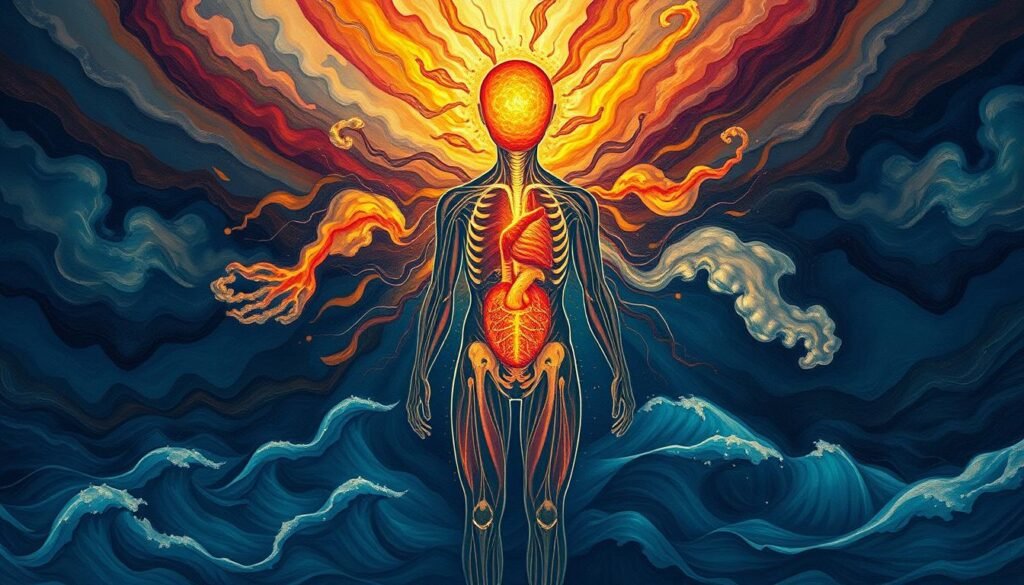About 70% of adults in the U.S. feel stressed or anxious every day. It’s vital to know the difference between stress and anxiety. Stress usually comes from outside things like work and lasts for a short time. Anxiety is more about what we feel inside, lasting longer and without a clear reason. This is important in figuring out how to deal with each one.
It’s critical for everyone, including doctors, to understand these differences. If not, people might not cope well or find the right help. By learning about stress and anxiety, you will know what triggers them and how to manage them better.
Key Takeaways
- Approximately 70% of U.S. adults face daily stress or anxiety.
- Stress is typically short-term, while anxiety is often more pervasive.
- Understanding stress vs anxiety aids in finding effective coping strategies.
- Mismanagement of these conditions can lead to serious mental health issues.
- Recognizing the differences is essential for appropriate professional help.
Defining Stress and Anxiety
Stress and anxiety affect people in different ways. Stress comes from outside pressures we can often point to, like job worries or arguments. This stress makes your heart beat faster and can change your mood. Normally, this stress goes away after the problem does.
Anxiety, on the other hand, keeps you worried for a long time without a clear reason. With anxiety, you feel uneasy and stressed even with nothing specific bothering you. About 31% of Americans will face an anxiety disorder during their lives. This shows it’s important to know the difference between stress and anxiety in daily life.
Understanding stress and anxiety helps in dealing with them. It’s common to find their symptoms mixing, making it hard to tell them apart. Handling them might include therapy, medicine, or changes in daily habits. This depends on what works best for the person suffering.
Stress: Causes and Triggers
Understanding the causes of stress means knowing the difference between short-term and long-term stress triggers. Short-term stress comes from things like tight deadlines or sudden issues. It causes a quick, intense response, including physical and emotional upset.
Long-term stress might come from ongoing health problems, not feeling secure in your job, or personal troubles. Reports show that about 70% of U.S. adults feel stressed or anxious daily. Around 47% suffer from high blood pressure due to chronic stress. This kind of stress can also lead to severe health issues like heart disease, which is the top cause of death in the U.S., taking about 696,000 lives each year.
Finding out what specifically triggers your stress is key to managing it well. There are lots of causes, such as:
- Childhood trauma or other bad experiences
- Losing your job or money problems
- Changes in relationships, like divorce
- Having too much to deal with
To handle these triggers, people can try different strategies for managing stress. Doing regular exercise, relaxing, and getting support from friends or family helps. Making a plan to deal with your specific stressors is very important if you’re dealing with ongoing stress.
In the end, knowing more about the causes of stress is crucial for improving mental health and happiness.
| Type of Stress | Duration | Common Triggers | Health Implications |
|---|---|---|---|
| Acute Stress | Short-term | Deadlines, exams, conflicts | Can lead to anxiety, headaches |
| Episodic Acute Stress | Occasional | Frequent challenges at work or home | Can cause high blood pressure, irritability |
| Chronic Stress | Long-term | Job insecurity, ongoing health issues | Can result in serious conditions like heart disease |
Anxiety: Understanding the Roots
Anxiety usually comes from both genetic factors and life experiences. Many people face stress that can lead to ongoing anxiety. This might be caused by things like relationship issues, school, or big life changes.
About 31.1% of U.S. adults will deal with anxiety sometime in their lives. This shows just how common anxiety origins are. Anxiety can show up in many ways, including general worry, panic attacks, and fears of specific things. Understanding where anxiety comes from is key to managing it.
Chronic stress is a big reason why people have anxiety disorders. It messes with the brain’s chemical balance, increasing the chance of developing anxiety. Over half of those diagnosed with anxiety say stress plays a huge part. Stress and anxiety together can lead to symptoms like a fast heartbeat, sweating, and feeling worn out.
- Over 40 million adults in the U.S. have an anxiety disorder.
- Approximately 7% of children aged 3 to 17 experience anxiety issues annually.
- Most symptoms manifest before the age of 21.
Understanding these elements is crucial for finding help. New treatments, such as Transcranial Magnetic Stimulation (TMS), are hopeful options. For many, tackling anxiety means exploring its complex anxiety origins and seeking personalized treatment plans.
Stress vs Anxiety: Key Differences
It’s important to know how stress and anxiety differ. They might seem similar but affect people differently. Stress is a reaction to a challenge. Anxiety is a reaction to stress.
Duration and Triggers
Stress and anxiety don’t last the same amount of time or have the same causes. Stress is usually short-lived and comes from clear sources. It goes away after the problem is gone. Anxiety sticks around longer and might not have an obvious reason. Being stressed for too long may lead to anxiety. This shows why understanding both is so important.
Symptoms Comparison
The signs of stress vs anxiety can look the same, which confuses many. Both can make you feel upset, tired, or give you a headache. Yet, anxiety feels worse and can make daily tasks harder. The table below points out the main symptom differences:
| Symptoms | Stress | Anxiety |
|---|---|---|
| Duration | Temporary, subsides when the stressor is removed | Persistent, can occur without identifiable triggers |
| Intensity | Generally matches the level of stressor | Often disproportionately high compared to the situation |
| Physical Effects | Headaches, muscle tension, gastrointestinal problems | Panic attacks, heart palpitations, chronic distress |
| Impact on Daily Life | Can affect functioning but resolves with stressor removal | Can significantly impair work, social life, and routines |
Knowing how stress and anxiety differ helps with right diagnosis and treatment. It leads people to the right help and ways to get better.
https://www.youtube.com/watch?v=a-n2ZcgjLso&pp=ygUQI3N0cmVzc2FuZGF4aWV0eQ%3D%3D
Symptoms of Stress and Anxiety
It’s important to know the differences between stress and anxiety. Both can show up in many physical and emotional ways. Recognizing these symptoms is key to improving mental health. It leads to better stress and anxiety management in everyday life.
Common Physical Symptoms
Stress or anxiety can cause several physical symptoms. Common ones include:
- Increased heart rate
- Fatigue or exhaustion
- Muscle tension or aches
- Digestive issues, such as stomachaches or nausea
- High blood pressure
- Sleep disturbances, including insomnia
Having trouble sleeping can harm both your mind and body. It’s vital to spot these physical signs early.
Emotional Symptoms
Emotional signs also offer clues about a person’s mental state. Common emotional symptoms are:
- Irritability or mood swings
- Feelings of being overwhelmed
- Persistent worry or anxiety that interrupts daily life
- Difficulty concentrating or making decisions
- Increasing feelings of nervousness
Spotting these emotional symptoms is crucial. Tailoring a coping strategy can help. Exercise and eating right can also improve how you feel.
| Type | Common Symptoms |
|---|---|
| Physical Symptoms | Increased heart rate, fatigue, muscle tension, digestive issues, high blood pressure, sleep disturbances |
| Emotional Symptoms | Irritability, overwhelming feelings, persistent worry, difficulty concentrating, feelings of apprehension |
The Body’s Response to Stress and Anxiety
Our bodies react to stress and anxiety with a system called fight or flight. This response kicks in when we see something as a threat. The stress response starts in the brain and makes hormones like adrenaline and cortisol.
These hormones make our heart beat faster, breathing quicken, and keep us alert. These changes help us deal with threats right away. However, if this response is always on due to ongoing stress, it can harm our health.
Long-term stress can lead to a higher chance of heart disease and stroke by 40%. About 60% of people say stress impacts their health, causing issues like stomach problems and trouble sleeping. With anxiety disorders affecting nearly 30% of adults sometime, it’s important to understand and manage this response.

| Physiological Response | Short-term Effects | Long-term Consequences |
|---|---|---|
| Stress Hormone Release | Increased heart rate | Heart disease risk |
| Rapid Breathing | Heightened alertness | Chronic respiratory issues |
| Heightened Sensitivity | Improved reaction times | Adverse mental health effects |
| Blood Flow Redistribution | Enhanced physical capability | Digestive problems |
Knowing how stress and anxiety affect us highlights the need for ways to manage it. Realizing the impact on our mental and physical health is crucial for a balanced life.
Coping Mechanisms for Stress and Anxiety
Stress and anxiety touch everyone at some points in life. It is critical to find effective ways to lessen them. This can be done by using relaxation methods and staying active.
Relaxation Techniques
Relaxation methods can greatly ease stress and anxiety. Using deep breathing, meditation, and yoga can calm your mind and body. Doing these regularly improves emotional health and well-being.
- Deep breathing exercises: Help center the mind and reduce anxiety levels.
- Mindfulness meditation: Increases awareness of the present moment, lowering stress responses.
- Yoga practice: Combines both physical activity and relaxation, enhancing mental clarity and calm.
Physical Activity
Being active is a top way to handle anxiety and stress. You should aim for at least 2½ hours of moderate or 1¼ hours of vigorous exercise each week. Working out three to five times a week for 30 minutes can boost your mood a lot.
Starting with short, 15-20 minute exercise sessions every day can also help. Having an “exercise buddy” provides support. It makes staying on track and motivated easier.
| Coping Mechanism | Benefits | Recommended Frequency |
|---|---|---|
| Deep Breathing | Calms the mind, reduces physiological anxiety | Daily |
| Mindfulness Meditation | Improves self-awareness, lowers stress | 10-15 minutes, several times a week |
| Yoga | Enhances physical and mental relaxation | 2-3 times a week |
| Moderate Physical Activity | Boosts mood, decreases stress levels | At least 2½ hours weekly |
| Vigorous Physical Activity | Improves coordination, fitness, lowers anxiety | 1¼ hours weekly |
These strategies help not just with stress and anxiety but also improve your overall health. They boost positive self-image and emotional steadiness. Combining these activities in a balanced way is key to managing stress and anxiety over time.
Managing Stress and Anxiety in Daily Life
Managing daily stress and anxiety requires a tailored approach that fits snugly into a busy lifestyle. One of the most effective tips for coping is to establish a structured routine. A consistent schedule helps individuals allocate time for work, relaxation, and self-care, promoting balance.
Prioritizing nutrition is also crucial; a diet high in ultra-processed foods can lead to higher perceived stress levels. Instead, focusing on whole foods enhances mental well-being.
Sufficient sleep plays a vital role in reducing stress and managing anxiety. Aiming for 7-9 hours each night can significantly impact mood and energy levels. Engaging in regular physical activity, such as aerobic exercise a couple of times a week, has shown to decrease overall stress and alleviate feelings of uncertainty. Exercise releases endorphins, which naturally boost mood and decrease anxiety.
Building a solid support system is essential for managing daily stress and anxiety. Studies indicate that individuals with lower levels of support tend to experience increased loneliness and depressive symptoms. Hence, maintaining connections with friends and family provides emotional support during tough times.
Another effective method includes practicing relaxation techniques like yoga and progressive muscle relaxation, both linked to lower cortisol levels and improved mental health.
Limiting screen time is advisable, especially in today’s technology-driven world. Excessive smartphone use contributes to high stress levels and can disrupt sleep patterns. A balanced approach to technology ensures better psychological well-being.
Integrating self-care practices like journaling can provide clarity and a sense of control in life. Regular journaling not only enhances the quality of life but also promotes healthier behaviors. Additionally, managing caffeine intake under 400 mg daily will help mitigate anxiety symptoms, as excessive caffeine can exacerbate feelings of tension.

| Practice | Benefits |
|---|---|
| Establishing a Routine | Promotes balance and structure |
| Physical Activity | Reduces perceived stress levels |
| Quality Sleep | Enhances mood and reduces anxiety |
| Healthy Diet | Protects against stress-related health effects |
| Strong Support Network | Improves resilience to stress |
| Relaxation Techniques | Lowers cortisol and anxiety levels |
| Limiting Screen Time | Improves psychological well-being |
| Self-Care Practices | Enhances quality of life and healthful behaviors |
Professional Treatment Options
Seeking professional help is crucial for many dealing with stress and anxiety. There are various treatment options available, designed to suit individual needs. These options focus on learning coping strategies and effective symptom management.
Psychotherapy for Anxiety Disorders
Cognitive Behavioral Therapy (CBT) is a top method for treating anxiety disorders in psychotherapy. It helps people change negative thought patterns that fuel anxiety. By attending regular sessions, individuals can improve their coping skills and learn to handle everyday stress better.
It’s important to note that anxiety disorders often happen alongside other mental health issues. These can include depression or substance misuse, which may make treatment more complex.
Medication as a Treatment Option
Sometimes, therapy alone isn’t enough, and medication becomes necessary in managing anxiety. Antidepressants can reduce symptoms effectively. There are also other options like buspirone for treating anxiety.
However, medications such as benzodiazepines and beta blockers should be used with caution. They are mainly for short-term relief to prevent dependency. Working closely with healthcare providers is key to finding the best treatment plan.
When to Seek Professional Help
Knowing when to seek professional help is key to managing stress and anxiety. Often, people miss the warning signs that they need support. Symptoms to watch for include constant unease, a lot of worry, and changes in sleep or eating.
Every year, about 19.1% of U.S. adults face anxiety disorders. This shows how common these issues are, affecting a large part of the population. In fact, 31.1% of adults will deal with an anxiety disorder at some point in their lives. This makes it important to know when to seek help.

If chronic stress disrupts your everyday life, you should think about getting help. You might need support if you:
- Can’t focus on tasks,
- Have big changes in how you sleep,
- Often feel panic or dread,
- Start pulling away from friends, or
- Use alcohol or other substances more.
Help can take many forms, like therapy, medication, or both. Therapy often works well, with a 70-80% success rate for those who engage fully. Also, therapy can cut symptoms of anxiety and depression by 50% or more for many people. This shows how important it is to act on warning signs.
It’s crucial not to ignore signs of distress. Asking for support can give you the means to take care of your emotional and physical health.
Conclusion
Knowing the difference between stress and anxiety is key to managing them well. Stress is usually caused by specific things, while anxiety is broader. About 31% of Americans will face an anxiety disorder in their lifetime. This fact shows how vital it is to know the signs and how to handle them.
It’s important to have good ways to deal with stress and anxiety. Doing regular exercise, trying relaxation methods, and building a network of support helps mental health a lot. Since over 70% of adults feel stressed daily, focusing on mental health is critical.
Handling the tough feelings that come with stress and anxiety takes knowing yourself and being strong. Learning about what makes them different and the signs helps people take control of their mental health. Sometimes, seeking help from a pro is needed. Using good coping skills can help people live happier and more stable lives.